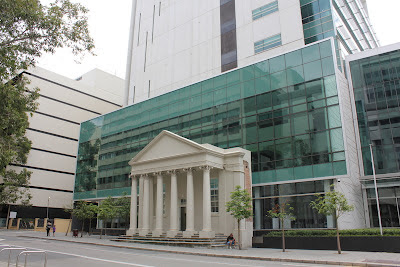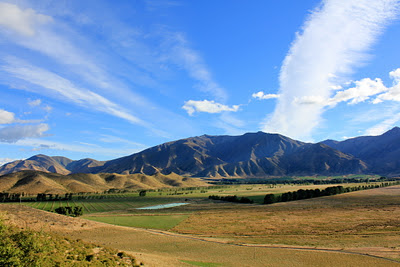Movies I watched: 'Moneyball' (decent), 'The Ides of March' (decent) and 'The Adventures of Tintin' (very nearly gave up on it - not the biggest fan of the books but on film the boy detective annoyed the shit out of me).
I arrived in Perth at 8pm (they’re 5 hours behind NZ) and was surprised to find it pitch black outside, then remembered WA does not 'do' daylight savings. It was a close, muggy evening after a scorcher of a day and I worried that the heat and humidity would mar my festival experience. I needn't have, as the temperature for the next five days was mild in comparison, never getting above 28 degrees and without much humidity.
But to experience the festival I first had to leave the airport, which took a while as the driver that was supposed to collect me was nowhere to be found. After a series of phone calls to organisers and drivers, I was picked up two hours after my arrival, by which stage it was 3am NZT and I was keen to check in to the hotel and hit the hay.
On Thursday all the international authors at the festival with the time and inclination to go on a boat trip were taken out the Rottnest Island. Gathered in the hotel lobby, waiting to be walked down to the jetty, I found myself standing opposite Germaine Greer.
'I like your t-shirt' she said.
Several possible responses occurred to me, most too frightening to offer to the author of 'The Female Eunuch', so I just said, 'Thanks.'
Our boat was rather flash and there was plenty of wine and soft drinks to be had on the voyage. It took about an hour to make it down the Swan River to Fremantle and then another hour out to the island.
 |
| Bottlenose dolphins, Swan River |
 |
| Rottnest Island from our mooring, Parakeet Bay |
The best part about the trip was just hanging out with the other writers who'd all arrived the day before like me. A very civilised way to ease into a festival, I must say.
In the evening, the festival kicked off with Germaine Greer's opening address on eco-feminism, which was delivered in Winthrop Hall at the University of WA. The entire campus is architecturally… forceful, but this grand hall is totally out there: a combination of a Viking mead hall and a Sicilian cathedral, replete with stained glass mandala, baroque marble floors and Aboriginal art on the rafters.
Afterwards, the writers and invited guests gathered outside for the PWF opening party. I was still getting used to the fact that you could hold an event like this outside, with no shelter or backup plan -- knowing I'd be appearing on this same lawn in two nights' time for The Feast of Words... The only gripe about the party was the minimal food. We'd boarded the bus at 5.30 to go to the opening address and it was past ten when we got taken back to town: a few slivers of lamb pide didn't cut it unfortunately. (See also: Stephen Romei's festival wrap for a glimpse of how other writers coped with the food shortage).
 |
| Winthrop Hall, UWA |
Friday: the festival started in earnest. My first session was 'Short, not so sweet', discussing the short story form with Janette Turner Hospital and Amanda Curtin. Counting on my fingers just now, I think this would have been my eleventh panel discussion in front of an audience since A Man Melting came out, and I think this one would have to have been the most rewarding.
The session was ably chaired by Georgia Richter, who managed to set the session off on an interesting path early (once we'd all given short readings: I read from 'Copies' for the first time years) and from then on it felt like a real conversation. We discussed the rewards and challenges of the form, the way ideas germinate, how some ideas are best suited to a short story (or a novel or a poem), how we approached the task of pulling stories together into a collection, whether we read other writers when immersed in our own work and how to deal with the agony of influence. There was just the right amount of agreement and divergence and we could have filled another hour, easily. And as an added bonus, the two questions from the audience were good'ns.
[You can read a very thorough account of the session at the Waxings blog...]
The session was ably chaired by Georgia Richter, who managed to set the session off on an interesting path early (once we'd all given short readings: I read from 'Copies' for the first time years) and from then on it felt like a real conversation. We discussed the rewards and challenges of the form, the way ideas germinate, how some ideas are best suited to a short story (or a novel or a poem), how we approached the task of pulling stories together into a collection, whether we read other writers when immersed in our own work and how to deal with the agony of influence. There was just the right amount of agreement and divergence and we could have filled another hour, easily. And as an added bonus, the two questions from the audience were good'ns.
[You can read a very thorough account of the session at the Waxings blog...]
We were all on a bit of a high after the session (having all been in ones that never quite reached top gear) and several audience members commented how much they enjoyed it. Ine said it was the best session they'd seen at the festival so far, but that's not saying much seeing how it was only the afternoon of the first full day. But I signed eight or ten books at the signing table, easily the most I've ever done after a single session, which I think is a good barometer (Janette and Amanda were also in high demand).
If only you could catch lightning in a bottle.
Earlier that day I sat in on a session about sex and literature featuring Krissy Kneen, Glen Duncan and Frank Moorhouse. I've read and admired the work of Moorhouse, but the others were new to me. After the first two writers gave readings involving octopus on octopus on human action and werewolf sex, Frank Moorhouse launched into a patchy tirade about the 'creeping gentilism' of all those warnings that come on before TV shows. He also called Glen Duncan 'Duncan' about six times during the session. You could see Glen considering whether to correct him the first few times, then, when he realised the chance had last, seething politely for the rest of the session.
On the van ride back to the hotel I had a great chat with Favel Parrett. We’re both working on books with sections set in the subantarctic, you see. To any writers festival artistic directors out there: once our respective books come out, you can chuck Favel and me on a stage and we’ll easily fill an hour with our passion for albatross and easterlies.
Friday evening I was invited to the dinner that Random House Australia put on for its authors. In the bar prior to going to the restaurant, I was involved in a small intrigue as I pretended to be the Perth-based friend of an author who shall remain nameless.
Here’s the backstory: Author X had recently switched publishers, but his tlast three books - the books he was promoting at the fest, had all been released by his old publisher. To their credit they were still supporting him and invited him to their dinner, but he was booked to go out with a friend that night and declined. The friend, however, came down crook and cancelled and in the course of drinking at the hotel bar Author X had been convinced to go to dinner with his new publishers. The only problem was that to get to the cabs waiting to take him to the restaurant, he had to pass through the lobby, and waiting in the lobby were a bunch of publicists and authors from his old publisher. I told him no one here knew what I looked like and I could pose as his Perth friend, allowing him to pass through the lobby without suspicion. It all went to plan until we go in the cab but had to wait for a third author to fill it. Meanwhile Author X was ducking his head down and muttering, 'quickly, quickly'.
Anyway, my publisher’s dinner was fun. I spent most of my time talking to Perth-based writer Sara Foster (who'd also been on the boat to Rottnest) and Nick Earls. I think I read one of Nick's books when I lived in Brisbane, but the details were sketchy - sometimes it almost better to have not read any books at all. Anyway, Nick and Sara were lovely and the time flew by.
I had Saturday to myself until the evening so I went for a walk around the city. My first impression of Perth was that it was a fairly typical Australian metropolis: flat, straddling a river, chocka with hideous 70s beige pebbledash monoliths.
And for a long time on my walk I felt that Perth's architecture was actually a new low, so hideous, so perfunctory, so leaden. But gradually the quirkiness of its older buildings emerged and I realised the whole place was batshit crazy. The UWA campus was not an aberration or a folly, but a natural extension of the craziness.
In the afternoon I headed out to the festival and caught the outdoor poetry reading featuring David Brooks (who chaired my session in the Blue Mountains at Sydney Writers Fest last May), Canadian Michael Crummey, Aussie Cate Kennedy and Ireland's Dennis O'Driscoull. All poets were fantastic in their own ways.
I then went to a session about building bigger works from smaller pieces featuring Julienne van Loon, Favel Parrett and my pal Frank Moorhouse. Again, the session was a bit disjointed (at one stage Frank's phone started ringing) but it was still worthwhile.
And then it was time for the Feast of Words... But you’ll just have to wait until tomorrow.































